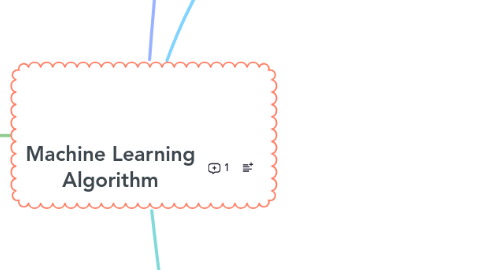
1. step Machine learning
2. Step to Work with ML
2.1. Data Clearnsing
2.1.1. Model Creation
2.1.1.1. Model Production
2.1.1.1.1. User Aceptance
3. Supervised Learning การเรียนรู้แบบมีผู้สอน
3.1. Linear Model
3.1.1. Linear Regression
3.1.1.1. Interpretable result by its outpur coeficients
3.1.1.1.1. Stock price prediction
3.1.1.1.2. Predictiing House Price.
3.1.1.1.3. predict Customer life time value
3.1.1.2. Applicable for multi-Class prediction
3.1.1.2.1. Credit risk score prediction.
3.1.1.2.2. Customer Churn Prediction.
3.1.2. Logistic Regression
3.1.3. Ridge Regression
3.1.3.1. Best suited where data suffer from multicollinearity
3.1.3.1.1. Predict Maintanace for automobiles
3.1.3.1.2. Predict Clinical outcome based on health data
3.1.4. Lasso Regression
3.1.4.1. Can handle high-Dimentional data
3.1.4.2. No need feature selection
3.2. Tree-Based Model
3.2.1. Decison Tree
3.2.1.1. Examinable and interpretable
3.2.1.1.1. Customer churn prediction
3.2.1.1.2. Credit scoring
3.2.1.2. can handle with Missing value
3.2.2. Random Forests
3.2.2.1. Reduce overfitting
3.2.2.2. Higher accuracy whem compared with other model
3.2.3. Gradient Boosting Regression
3.2.3.1. Better accuracy compared to regression model
3.2.3.2. handle Multicolinearlity problem
3.2.3.3. handle Non-Linear relationship
3.2.4. XGBoost
3.2.4.1. Provide the best suit accuracy result
3.2.4.2. Capture the Non-Linear relationship
3.2.5. LightGBM Regressior
3.2.5.1. Can handle with large amount data
3.2.5.1.1. Predict the fight time airline
3.2.5.2. Efficient & Fast training speed
3.2.5.3. Low Memory usesage
4. Unsupervised Learning การเรียนรู้แบบไม่มีผู้สอน
4.1. Clustering
4.1.1. K-Means
4.1.1.1. Scales Large dataset
4.1.1.1.1. Supermarket customer segmentation
4.1.1.2. Simple implement and interpret
4.1.1.3. Result type in Group Cluster
4.1.2. Hierachicat
4.1.2.1. There is no specific number of clustering
4.1.3. Gaussian Mixture
4.1.3.1. Compute the probability for an observation belonging to a cluster
4.1.3.2. Can identify the overlap clustering
4.1.3.3. More accurate result compared with K-Means
4.2. Apriori alogrithm
4.2.1. Result are intuitive and interpretable
4.2.1.1. Product placements
4.2.1.2. Recommendation engines
4.2.1.3. Promotion optimization
